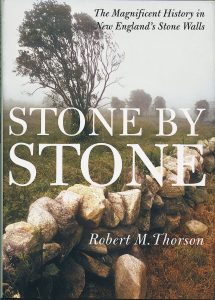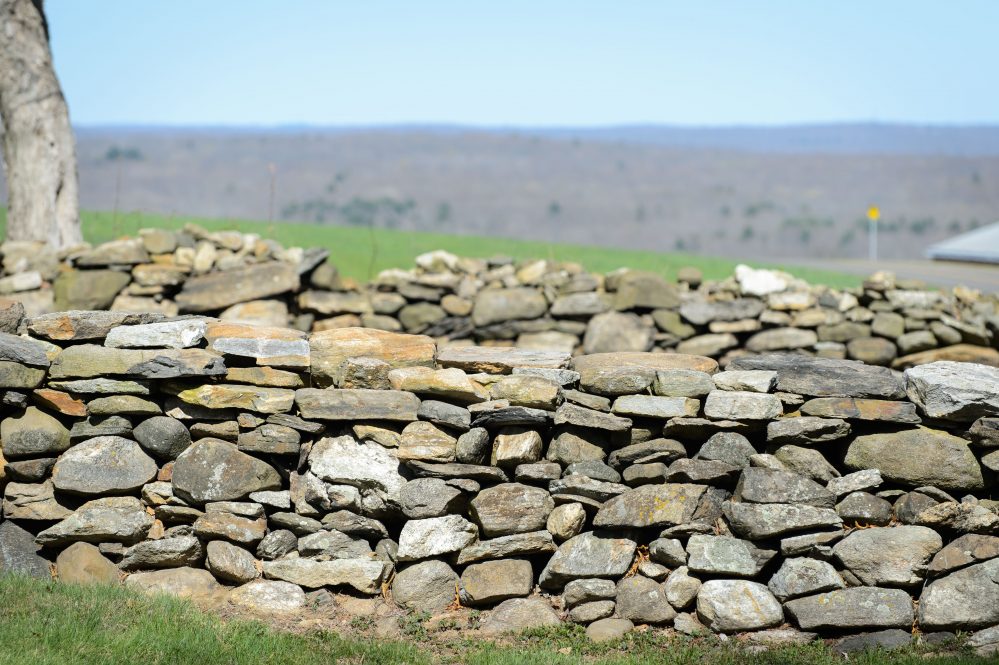New England’s landscape is known for many things, such as the brilliant diversity of colorful foliage on display each autumn. It is at this time of the year when another iconic landscape feature re-emerges as the leaves fall – thousands of miles of stone walls. Sometimes sinuous, sometimes geometric, stone walls are a signature feature of the New England landscape, a latticework of bare rock in an otherwise plant-covered world. When viewing them up close, it becomes clear that stone walls are also vital features of the ecosystem, with an abundance of creatures making their homes in and around them.
UConn Professor of Earth Sciences Robert Thorson has studied and defended stone walls for years, while writing books, giving talks, and leading hikes surrounding the subject. Now, in a paper published in Historical Archaeology, he is leading the effort to rethink how we view these landforms and establish the science of stone walls to get the ball rolling to ensure their preservation.
Creating Definitions and Order
A vital first step in any scientific endeavor is to organize and establish a precise naming and classification system. Much like the Linnean Taxonomy that elegantly orders life into distinct branches based on defining characteristics, Thorson saw the same need for stone walls.
The process started years ago when Thorson began gathering information on hikes or at talks where he would ask others what they called the different configurations of stones.
“I kept asking, ‘What do you call that?’ And they’d call it something, usually with a mix of nouns and verbs, for example, ‘a single stack wall,’ a standard phrase I’ve heard hundreds of times,” Thorson says. “But that phrase conflates two things that often lead to misinformation. It is great to have names that have cultural or emotional resonance, but, for public management, we need to have a classification system founded on objectivity and not nuance.”

Thorson asks: “Is it a fence, or a wall? Is it an elongated pile? Is it a stone wall or a rock wall? Why define it all? These questions may not seem like a big deal until you start to understand that these structures are important historical artifacts that simultaneously play important roles in the landscape. Though some of the walls appear to be no more than loosely organized piles of stone, there’s usually an interesting story not told in written documents and not designated on habitat maps.
“In the Anthropocene, it’s time for us to start looking at things scientifically because they are the result of the overall major human impact in the last few millennia. To move into managing this landform, this resource requires that we have evidence-based management, which requires precise definitions. That’s what the paper is all about. It’s a taxonomy, nomenclature, and protocol so we avoid misinforming people. Words are so potent and so powerful.”
Wetlands
A parallel for the case for stone wall preservation is the story of the fight for wetlands protection. Thorson says this emphasizes the necessity for precise terms and definitions for both science and law because ultimately, laws are key for land and resource management.
“We need good definitions. If you passed a rule saying no more removal or strip mining of stone walls, doesn’t that mean you need a definition of a wall? One contractor could hire a lawyer saying an example isn’t a wall whereas somebody could hire another lawyer saying it is.”
These types of disputes are a common issue and Thorson says he fields questions regularly. Ordinances for stone walls, where they exist, change from town to town and are inconsistent. Thorson says the same was also true for wetlands, which only became broadly federally controlled after the Wetland Conservation Act was passed in 1991. Thorson, while working on wetland stratigraphy, watched and contributed to the formulation of policy starting in the late 1980s, and he explains it started with people not realizing the significant value of wetlands, and opting to get rid of what they regarded as eyesores on the landscape. Scientists worked to convince the public and then there was momentum to figure out ways to manage and protect them:
“That’s when the lawyers get involved, and the Supreme Court ultimately decides what is the waters of the United States and what isn’t. Science is about the real world and law is about the rules we make about the real world. Finally, we passed a set of wetland laws that targeted conservation, habitat, flood control, water quality, education, natural history, and many other qualities.”
Thorson hopes for a similar outcome for stone walls and that this taxonomy can be used as a tool to formulate conservation policies like those for wetlands because stone walls are also ecologically critical. Stone walls act as important habitats and microclimates bringing diversity to the landscape by creating dryer areas where animals like chipmunks, bobcats, or foxes can live or hunt above the damp forest floor. Thorson also says he has seen examples where walls divert water and create streams or wetlands.
“They are so integrated into the landscape,” he says. “Imagine the old-growth forests, covering the hills and valleys. Now, imagine the surge of physical and biological changes that rippled through the landscape when they were cut down. Now if those more than 100,000 miles of stone walls vanished, there would also be a surge of change through the landscape. Without the walls, billions of creatures that require this habitat would die while others would move into remaining fringes where they compete for territory, and whole parts of the food chain would die off.”
Precision and Preservation
Stripping the landscape of a stone wall robs the ecosystem of the structure that so many elements of that ecosystem rely on. Thorson is hoping the taxonomy can help shape policy that will protect stone walls. For years, the walls have been buried, used to fill wetlands, crushed for road construction, or sold and shipped elsewhere.

“This is very important to me, and I want to ensure we don’t strip mine these resources away. This paper is a culmination of my efforts and the first steps toward establishing stone walls as a science.”
Thorson worked through the tedium that comes with organizing and establishing a naming system. His system, like other taxonomies, is binary and relies on yes/no questions based on criteria like height, continuity, and how many stones thick the wall is to arrive at the classification. Also, like other taxonomies, Thorson is expecting an iterative process to continue refining the method with feedback now that the paper has been published.
“I’ve been very reluctant to publish this, because though I love the rigor of taxonomies, the idea of taking a continuum and cramming it into rigid, binary categorical thinking is dangerous,” says Thorson.
But with what he sees happening and the number of inquiries he regularly receives for advice, Thorson decided that it is too important an issue to put off and decided to publish the taxonomy “warts and all.”
“A while ago, I was driving west, probably to give a talk on stone walls, and I got stuck on Interstate 84. While sitting in traffic, I noticed right next to me was an 18-wheeler loaded with pallets of New England stone,” he says. “I could see the lichens, mosses, and silt still hanging off the stones and it bugged me. I don’t think we should do this. This paper is a service to the region, to protect stone walls as landforms and artifacts and the ecosystems.”
For more information, visit the Stone Wall Initiative website, or you can read or listen to Thorson’s book Stone by Stone.



